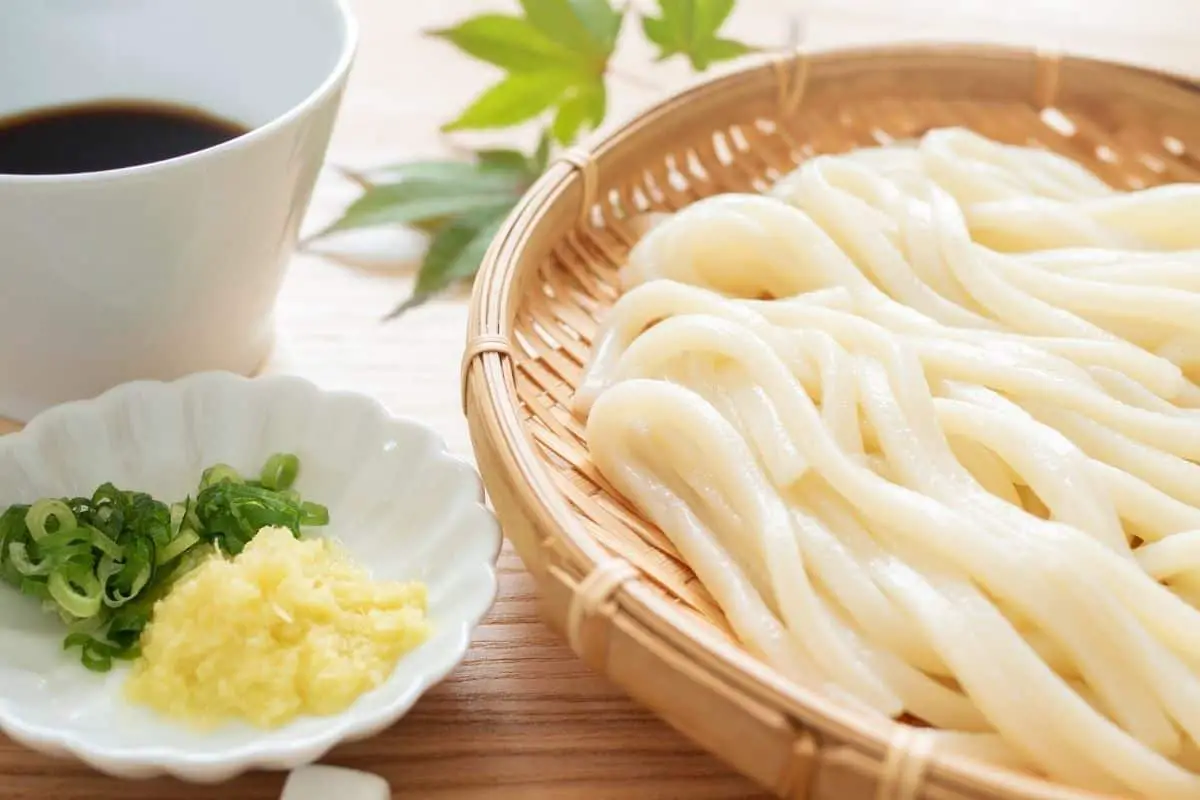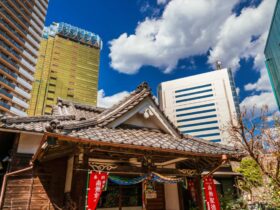Udon noodles are created by kneading wheat flour. Udon is one of Japan’s three favorite types of noodles. The other two being soba and ramen. Across Japan, there are different types of udon as well.
Udon is best eaten with dipping sauces where the noodles are partially dipped into a flavored sauce and then quickly slurped into the mouth to enhance the taste.
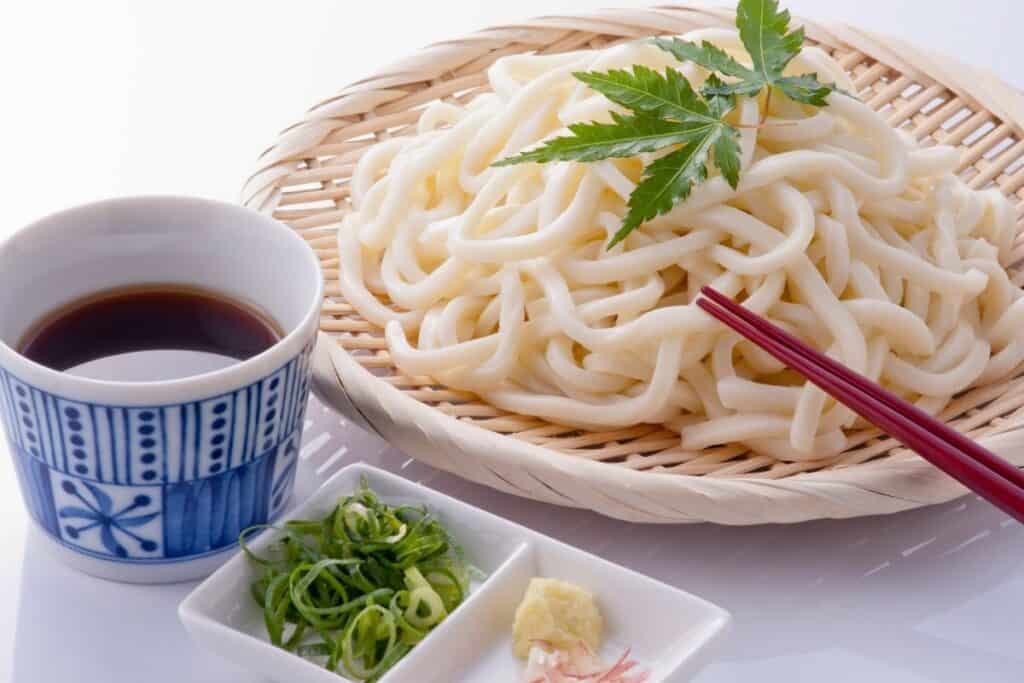
The area best known and perhaps the center of the Udon noodle is Kagawa prefecture. Udon began in the 18th century and was loved by the Japanese nearly as much as rice.
Udon was Japan’s first original fast food for people who were in need of a quick meal. Even today Udon restaurants may have standing counter areas for their customers to grab a quick meal and get on their way.
In total, two of the most common noodles in Japan are the soba and udon types. Soba is thinner and has a light brown color to them. Made primarily from buckwheat flour mixed with a smaller percentage of wheat flour. Udon is made from wheat flour and is generally a thicker-sized noodle.
Udon only has three ingredients: wheat flour, water, and salt. Wheat flour is carefully mixed with salt and water. The salt content is carefully measured as even a change in humidity will require the salt amounts to be changed.
The udon flour is either hand mixed or machine mixed. Heavily mixing the flour will allow the noodles to have a firmer and more sticky texture form from the gluten.
The dough itself rests overnight after mixing and the following day it is rolled out carefully with a rolling pin or with a machine to thin out the dough.
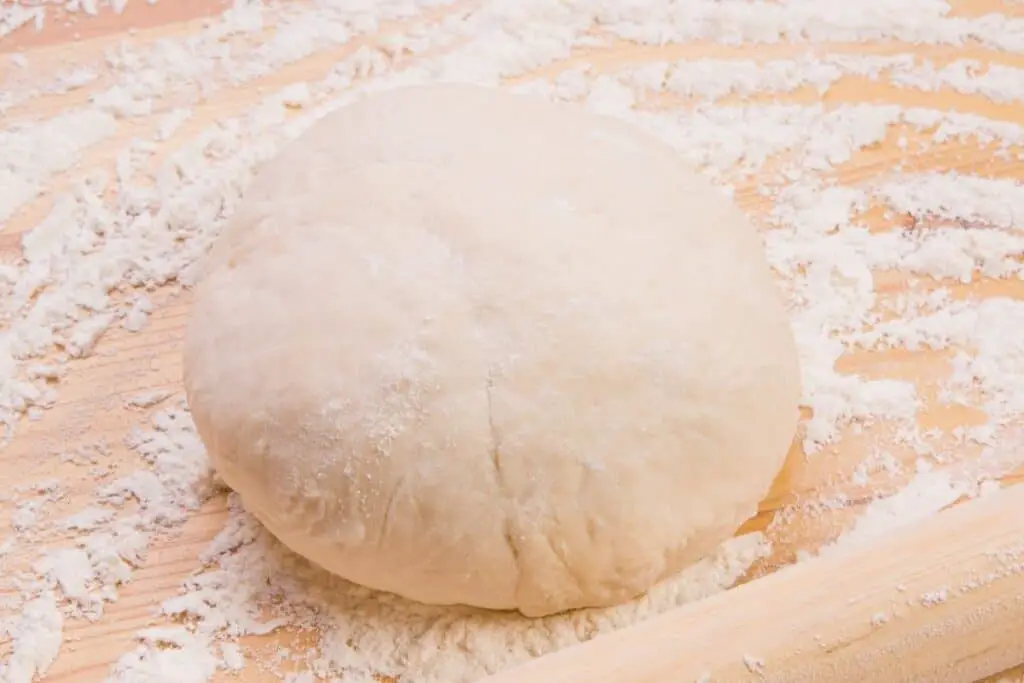
It takes much practice to be able to get the dough to the proper thickness. Once the dough is at its optimal thickness the chef will cut the dough into exact widths.
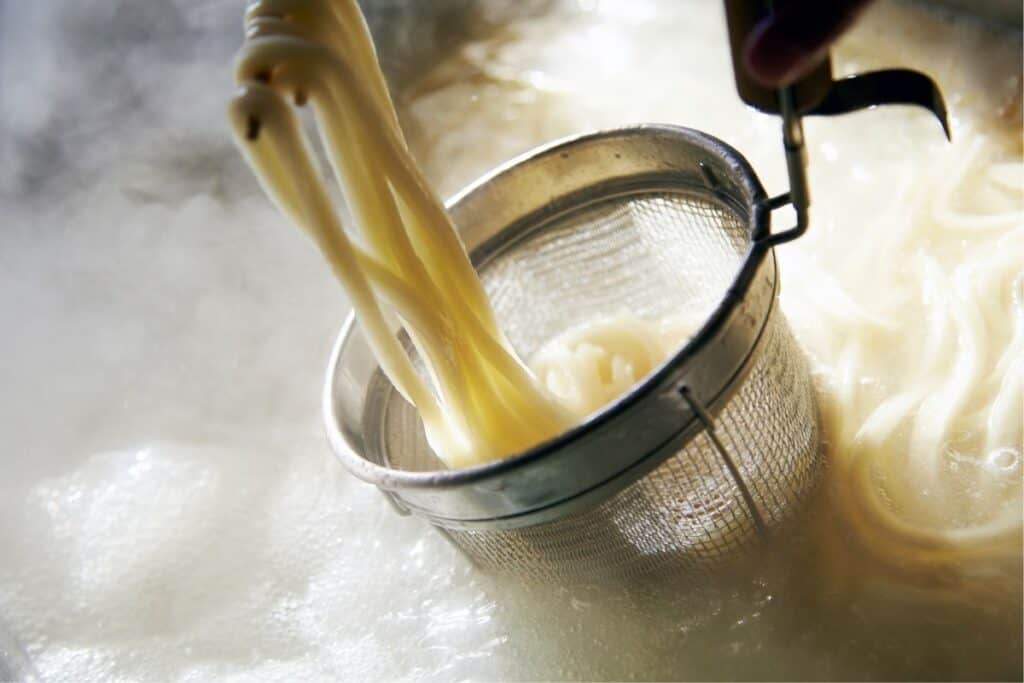
Noodles will be boiled for only a few minutes. Once the noodles have cooked they are quickly put into a bath of cold water. This too aids in the firmness of the noodles.
As a general rule, a typical udon meal will consist of udon noodles which have been immediately boiled before eating. The most common dipping sauce for the udon is made from seaweed (Nori), sardines, and a careful mix of soy sauce.
Cold udon is served as follows, once the udon noodles are boiled they are bathed or rinsed in cold water and served with a cold dipping sauce. When the noodles go thru this cooling treatment they become somewhat chewy.
A third way udon may be served to the customer is to have them submerged in a broth. The broth itself is made from the dipping sauce only diluted. Often the dish will be topped with a variety of food items.
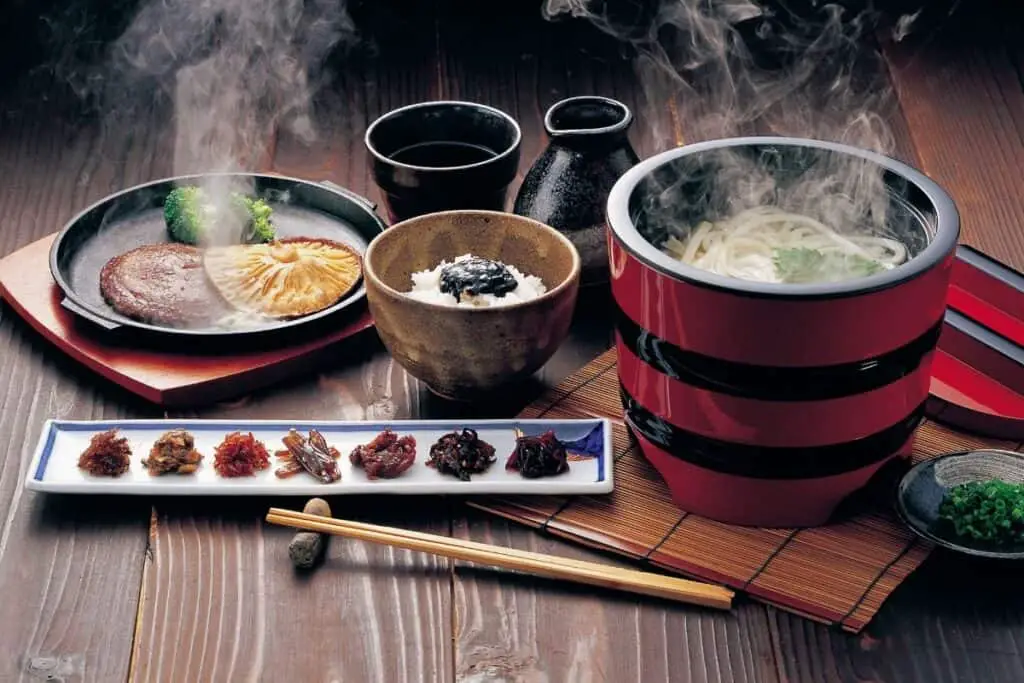
Udon dishes have developed from the varied regions of Japan, giving the country a very large variety of options when ordering an udon dish.
The noodle itself also comes in a variety of shapes depending on the area of Japan where the dish originated. In some regions, they may be a 1 inch wide think noodle, to a very rounded thin noodle.
It’s said that udon is better for you than Ramen…
As a general rule Udon is slightly healthier for you in the fact that it contains a smaller amount of salt. Udon is also made from fresh ingredients and contains no MSG. The ramen itself can contain a substantial amount of sodium and MSG, therefore, would be less healthy.
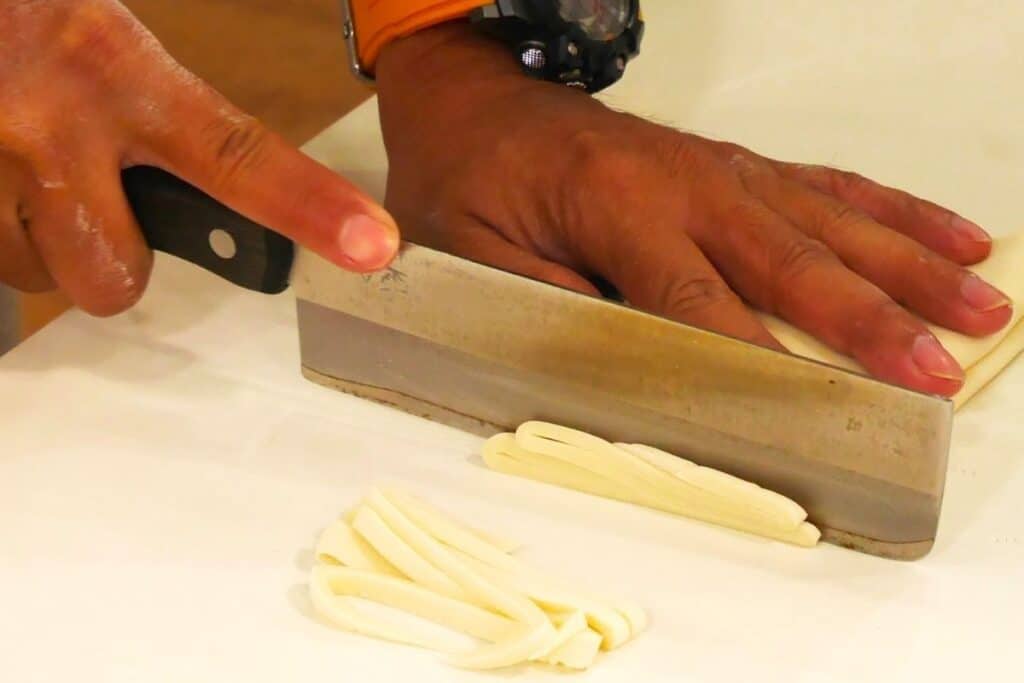
The best Japanese restaurants will consistently make fresh noodles each day to have the best possible flavor. Udon can be topped by dozen of varieties of fried (tempura) items.
Common Udon Dishes
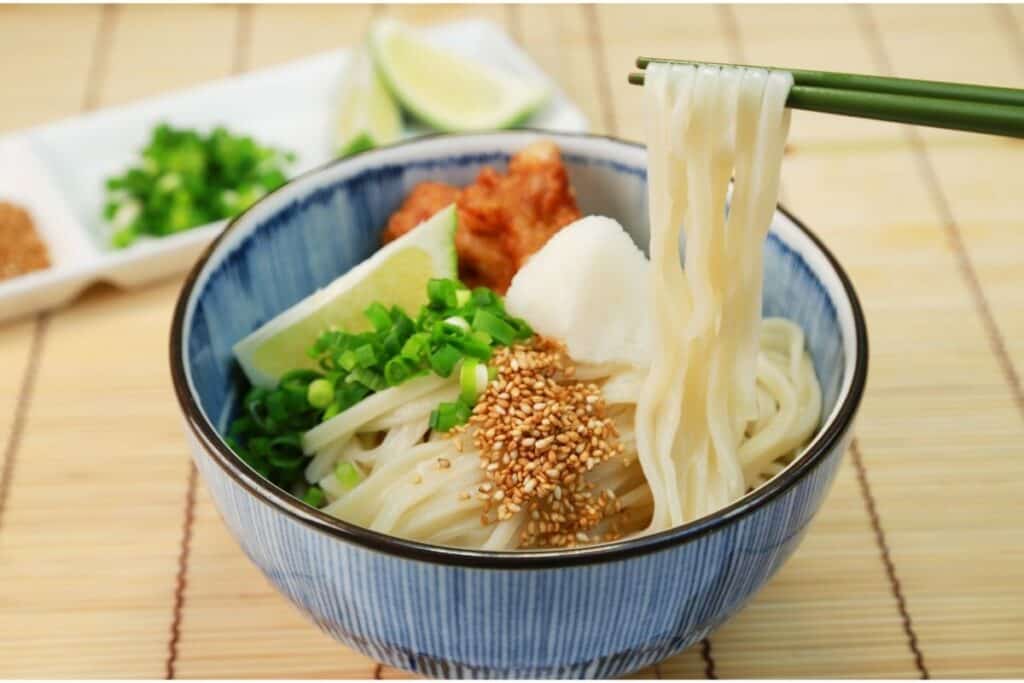
UDON CHIKARA (JAPANESE POWER UDON)
Chikara Udon (Japanese Power Udon) is a kind of Japanese Udon with toasted Kirimochi (rice cakes), spinach, negi (green onion), and kamaboko, thick, chewy udon noodles lay in a creamy dashi broth (fish cake).
When eating mochi, use caution, especially with small children and people who have difficulty swallowing. It is extremely chewy and can cause choking.
Nicknamed power udon as the belief that eating the mochi with udon gives one strength.
Generally served hot.
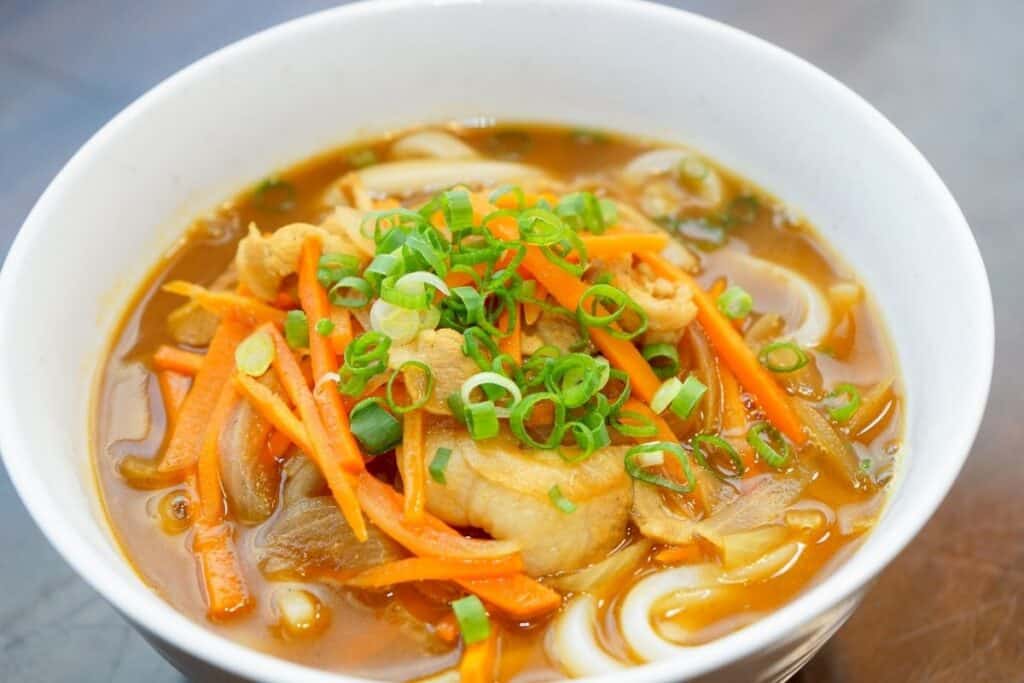
Curry Udon
Curry udon has been a popular menu dish in Japan. Although it is less well-known than Curry Rice, the creamy curry base is just as satisfying when served with udon.
This dish is served hot and sometimes has a spicy flavor. Curry udon is a favorite of the Japanese on cold winter days as its filling and warms you up.
Always Served hot.
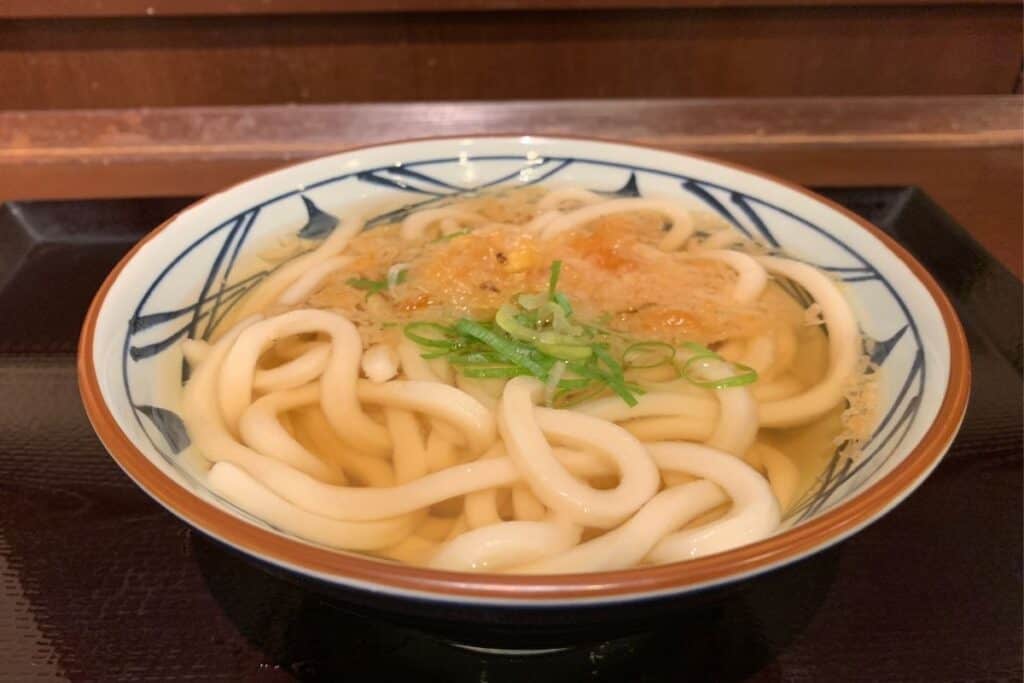
Kake Udon
Kake udon, where noodles are put in a simple soup stock named kakejiru, is the most basic and classic manner of making udon. Kakejiru is a combination of soy sauce, mirin, and dashi, three of the most popular ingredients in Japanese cuisine.
Generally served steaming hot.
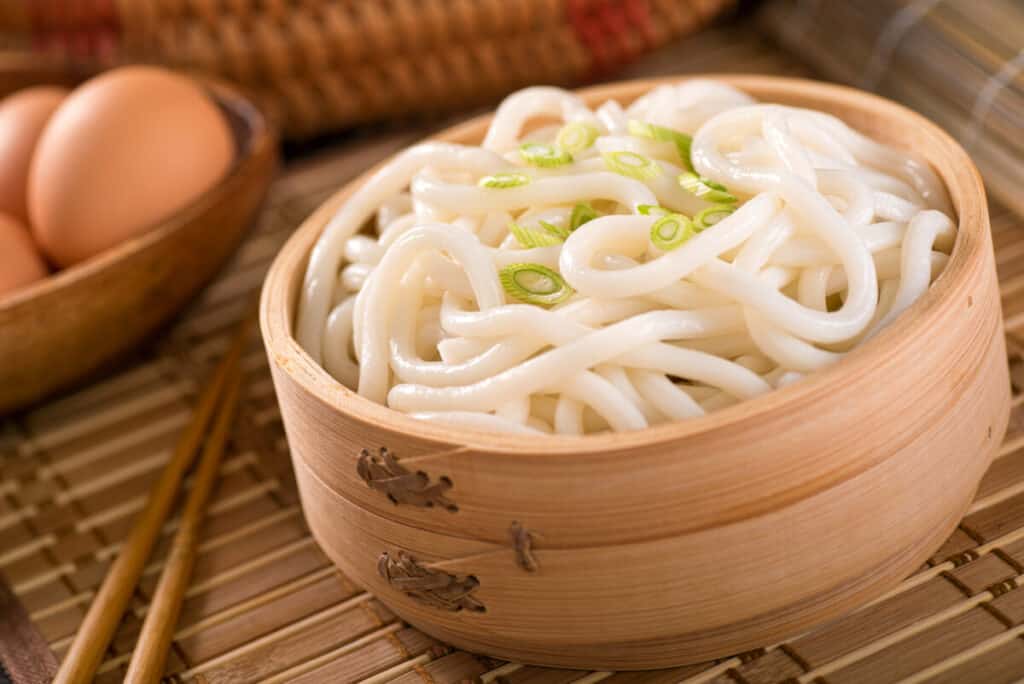
Kamaage Udon
Kamaage Udon noodles are prepared with a dipping sauce and a choice of spices in hot water. Individual quantities of Kamaage Udon are served in wooden bowls in some locales, while family-sized amounts are served in big communal wooden noodle tubs in others.
Generally served hot.
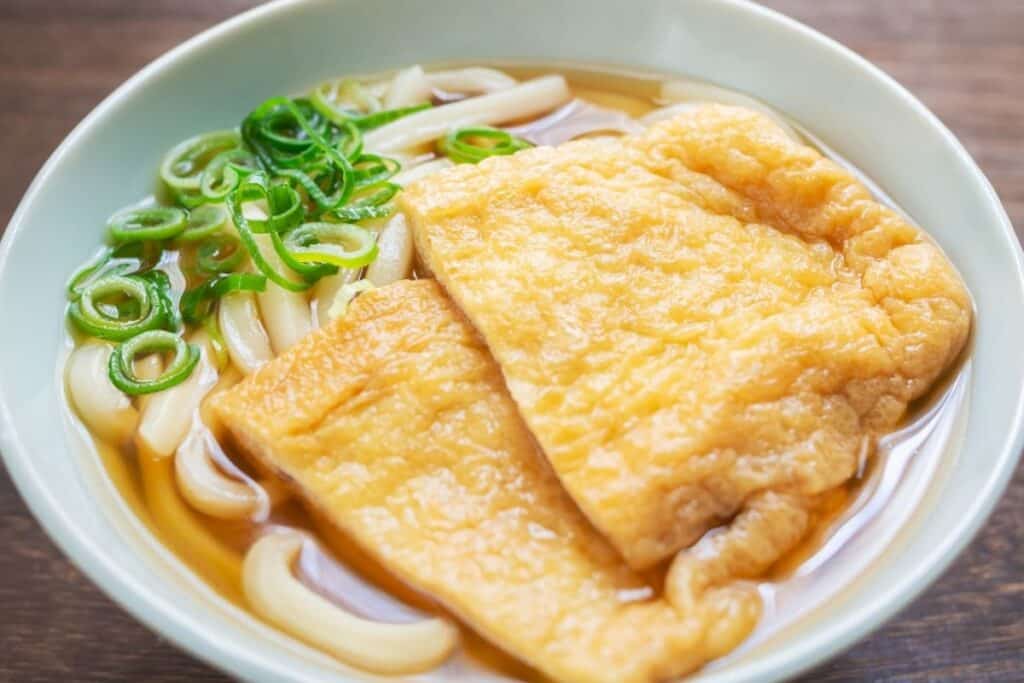
Kitsune Udon
Kitsune is the Japanese word for fox.
Kitsune udon is a tasty meal cooked of thick udon noodles served in dashi-based soup stock with a large piece of fried tofu (considered to be the fox’s favorite food) and a large piece of fried tofu (believed to be the fox’s favorite food).
During the winter, it’s impossible to resist a wonderfully warm bowl of Kitsune Udon. With its luscious, plump deep-fried tofu seasoned with sweet soy sauce, chewy Udon noodles, and basic but subtle broth.
Is served both hot or cold.
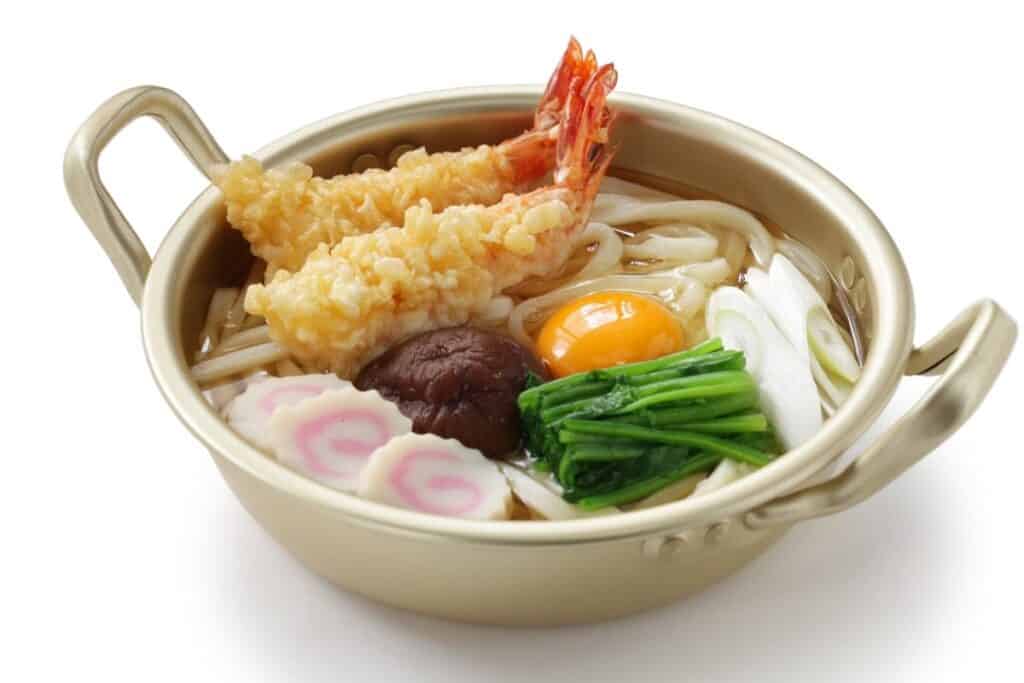
Nabeyaki Udon
Nabeyaki Udon is a traditional hot udon dish served in individual donabe (earthenware pots) or metal pots.
The soup generally contains chicken, kamaboko (fish cake), mushrooms, and vegetables like spinach, long green onion, and carrot, in addition to udon noodles. On top of it, there’s a raw egg and often served with shrimp tempura.
Served hot and many establishments only serve this dish in cold winter months.
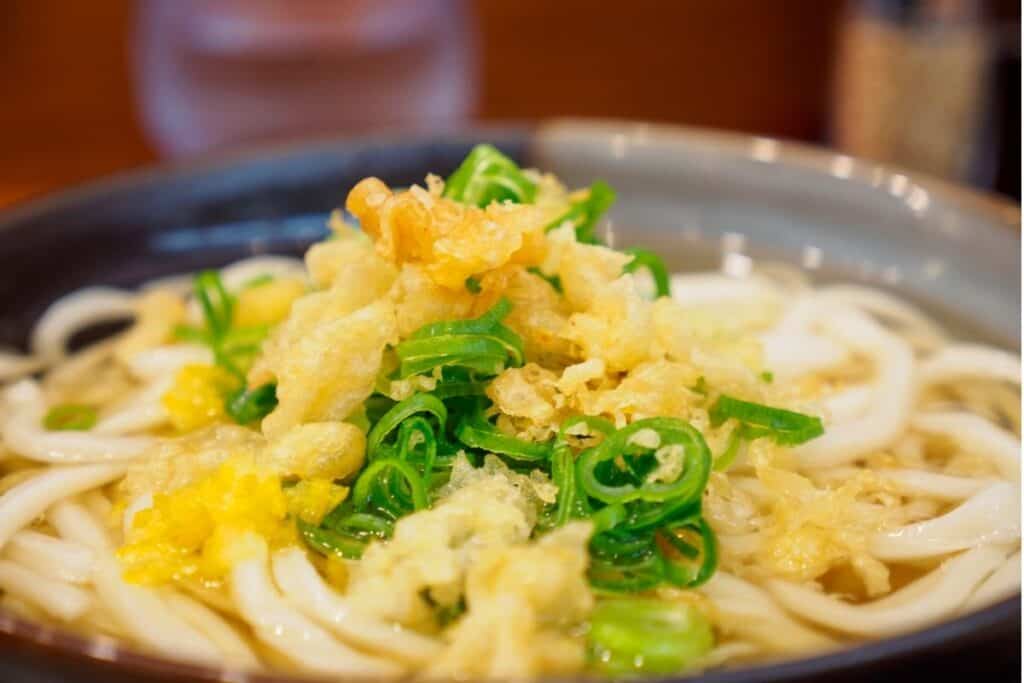
Tanuki Udon
Tanuki udon is a dish made of thick udon noodles in a dashi broth with tenkasu tempura flakes. Tanuki udon is named after the raccoon canines known as tanuki in Japanese folklore.
A less common Udon dish in the city of Osaka as tempura batter is often free in the local restaurants there.
Served hot or cold.
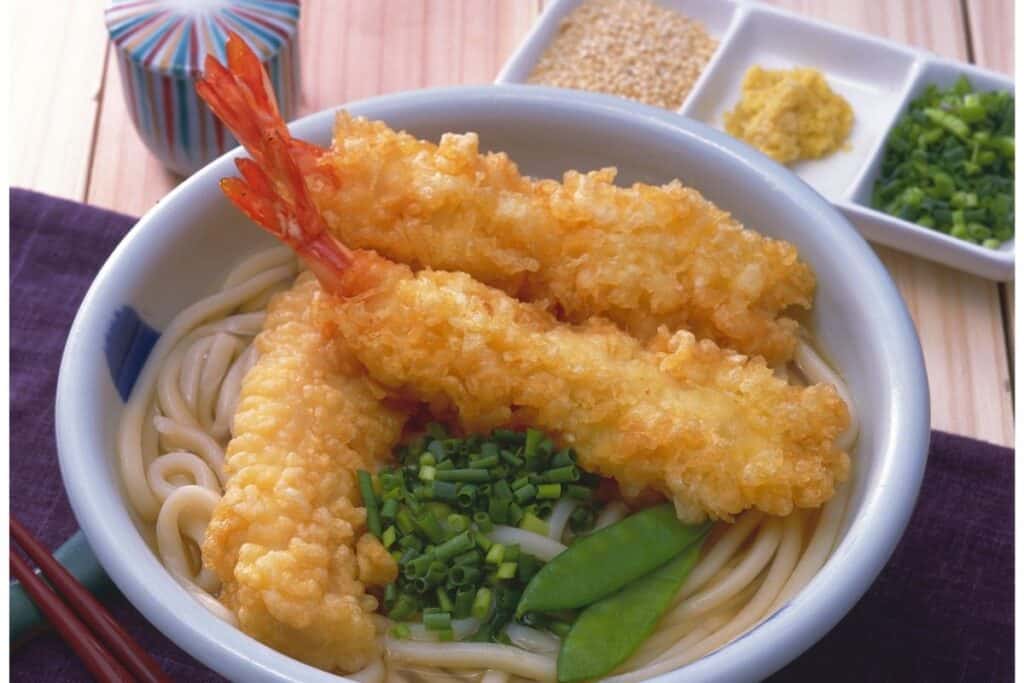
Tempura Udon
Crispy shrimp tempura, fish cake, and chopped shallots/scallions are served on top. The saltiness and sweetness of the dashi-based broth complement the tempura well.
Served hot or cold.
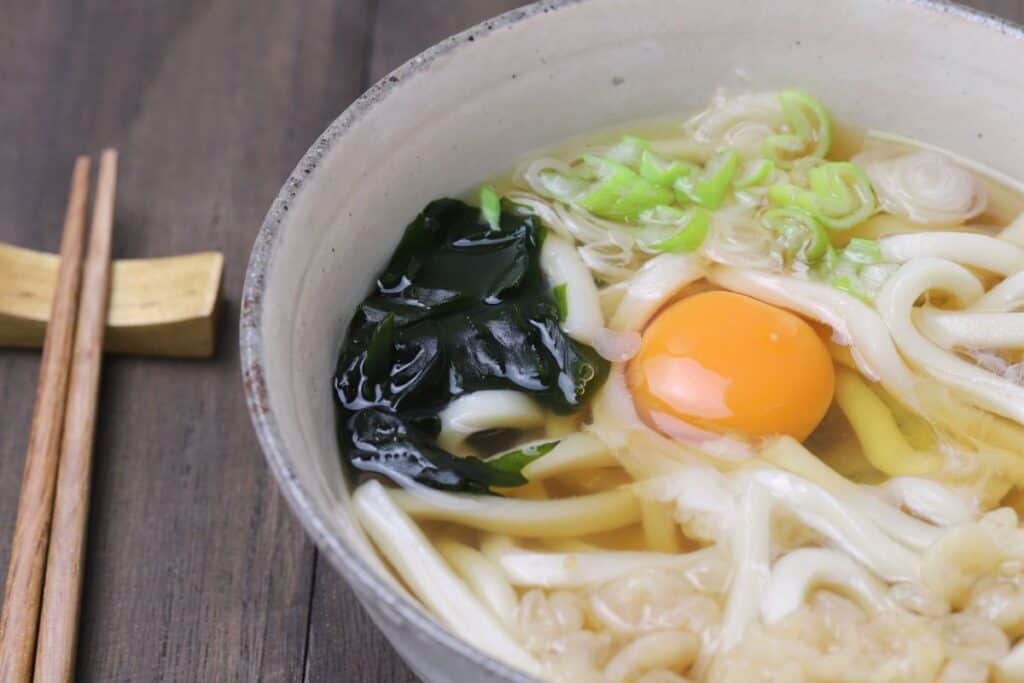
Tsukimi Udon
This traditional udon noodle dish, named after the raw egg that represents the harvest moon, Poaching the eggs in the dashi-soy-sake broth instead of water gives them a more robust taste in this recipe.
Served hot.
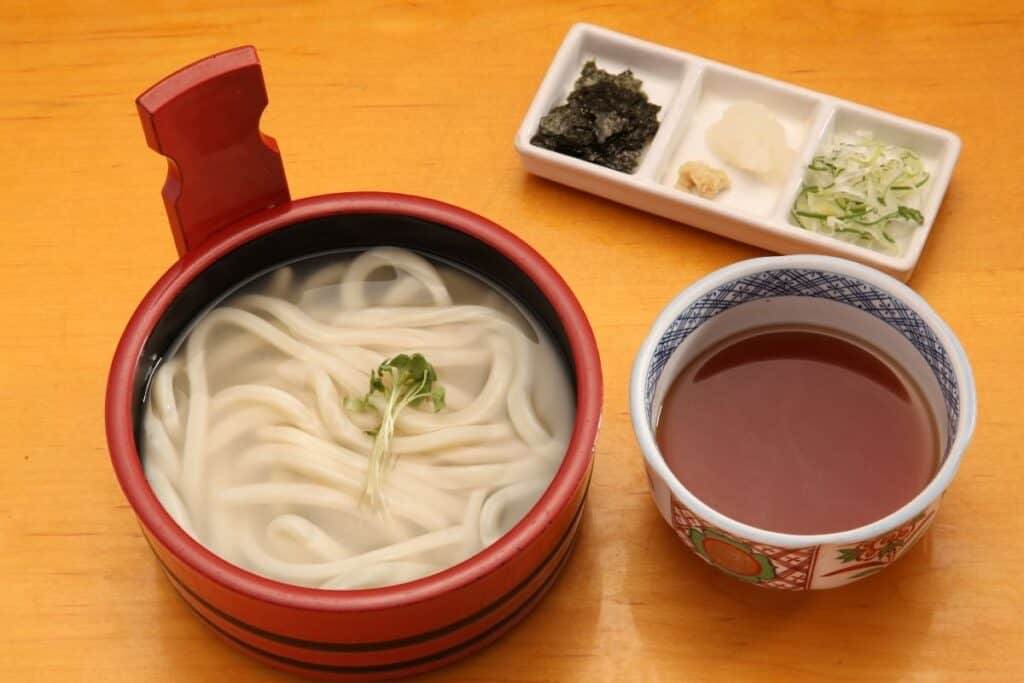
Zaru Udon
This meal is a summer classic in Japan, featuring chilled udon noodles and a wonderful handmade mentsuyu dipping sauce! It’s simple to make and goes well with tempura.
Served cold.
Finding Udon In Japan
Because udon noodles are so popular, they may be found in locations other than eateries, udon noodle shops, and udon noodle stores. visiting an udon specialist store for unique udon or those who want to choose from a range of udon types.
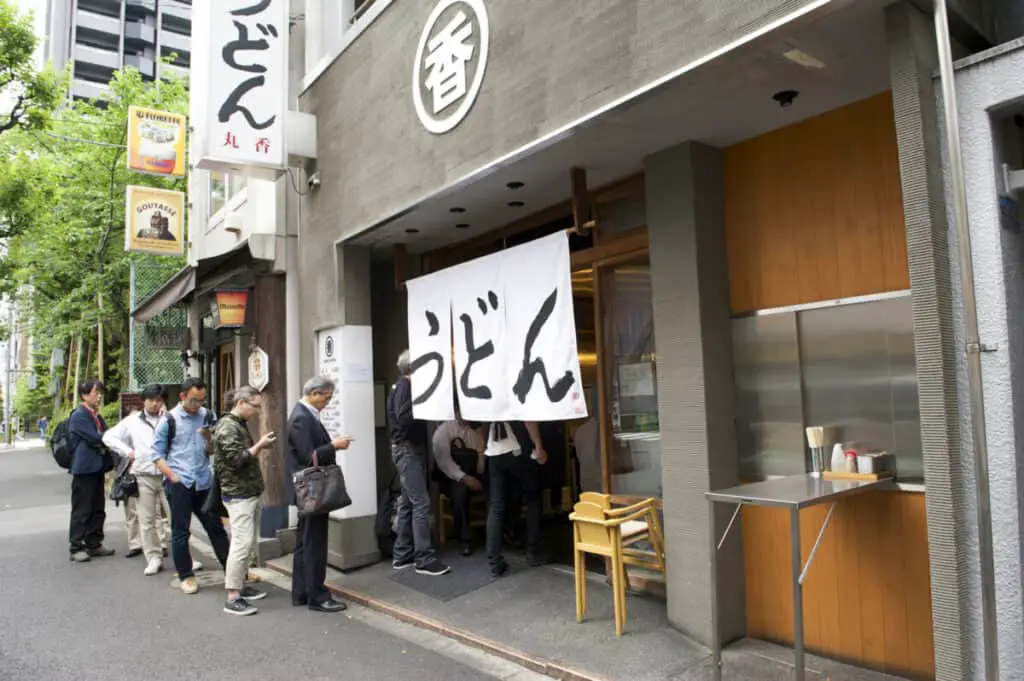
Some restaurants necessitate that you take the bowl, queue up, and bring it to the counter. These businesses will allow you to choose sides while waiting in line, after which you may order and pay.
There are many restaurants where you may buy tickets from a vending-type machine for your order. Payment can be made to the machine and you will receive a ticket and then wait on your order to be made.
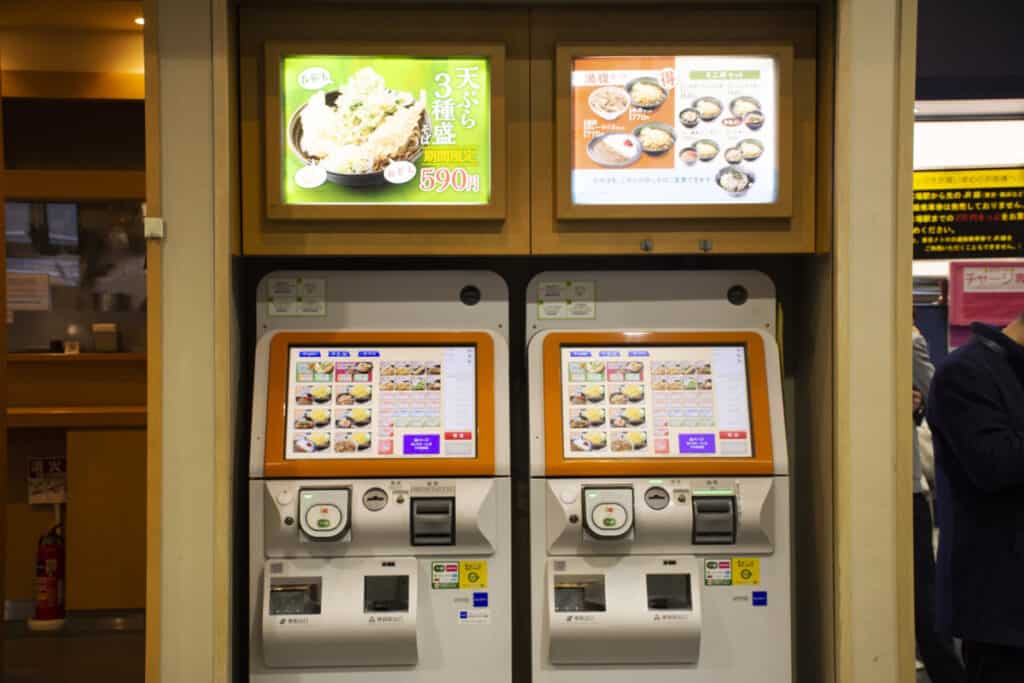
Eating Udon
Use your chopsticks to bring the noodles into your mouth while producing a slurping sound when eating udon in a soup or sauce.
As the heated noodles enter your mouth, slurping intensifies the tastes and helps cool them down. If there is broth, it is consumed directly from the bowl, without the use of a spoon.
Udon is one of the most popular dishes in Japan and has a myriad of varieties of topping styles and tastes. Sometimes depending on the season or city, you are visiting, you will find a delicious meal that is Udon.
Itadakimasu: “to eat and receive”
japanese saying before eating

